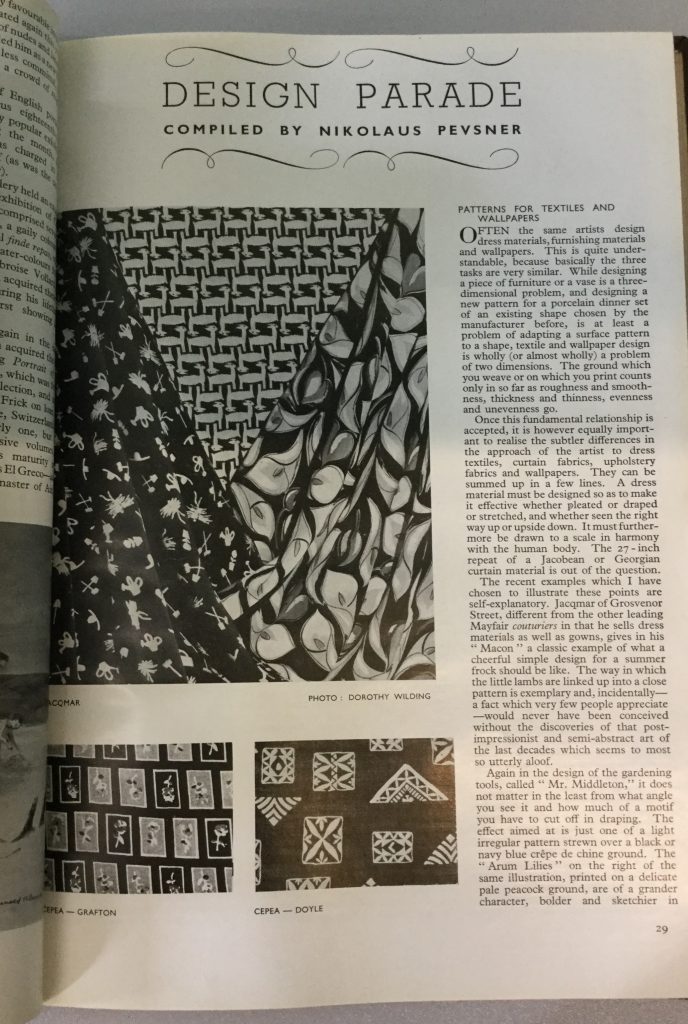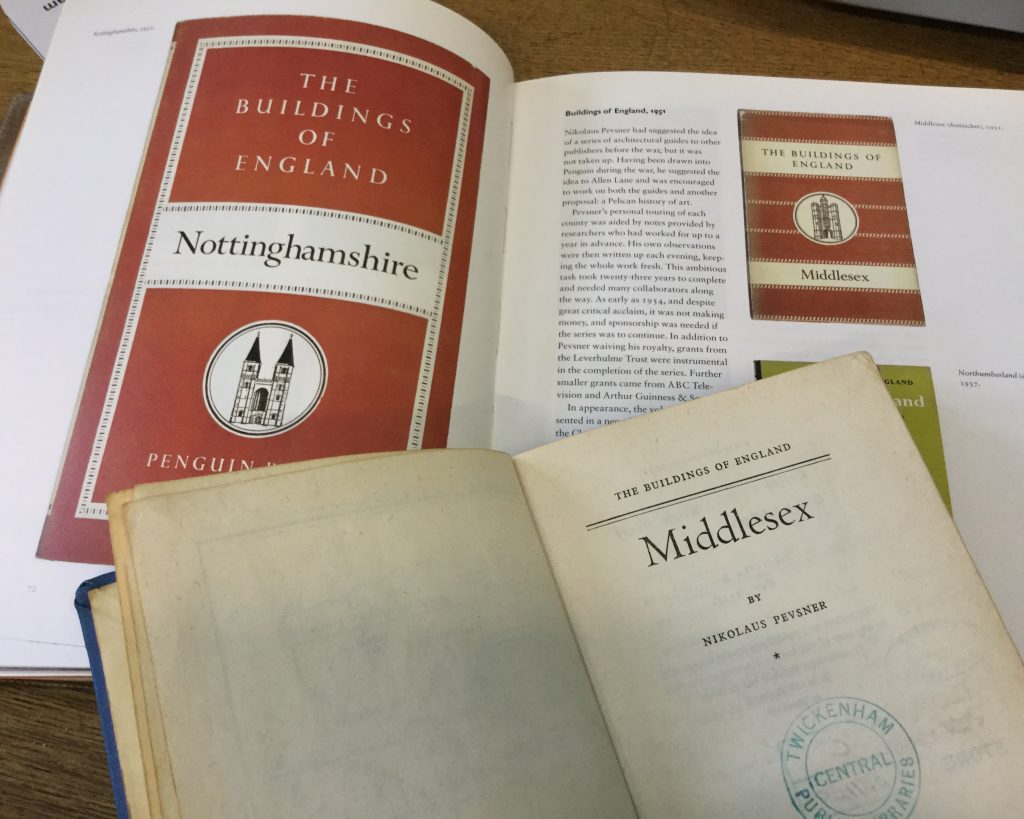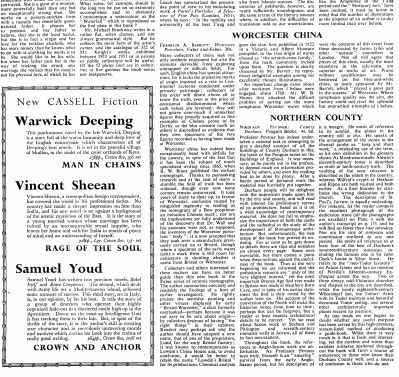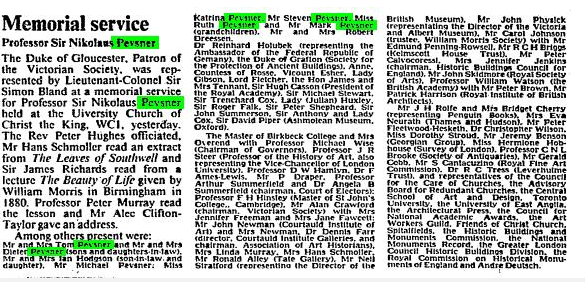Pevsner: the Man and His Eponymous Architectural Guides
Nikolaus Pevsner was an academic and writer. He was born in Leipzig in 1902 to Russian-Jewish parents who had moved to Germany at some point before 1900. His parents took German citizenship in 1914 and changed the spelling of their surname from Pewsner to Pevsner. He was one of a number of Austrian and German art historians who left Nazi Germany for Britain in the 1930s bringing with them the founding methods of art and architectural history and helping to develop the subject as a discipline and to bring it to a wider audience. Pevsner arrived in England in 1933 and he published Pioneers of Modern Design in 1936, which is still in print today and is a classic text on design and architecture. (E H Gombrich – author of another classic text The Story of Art – was another emigre). Pevsner was interned at the beginning of the Second World War but the intervention of his friends meant that he was quickly released. After working briefly as a labourer, clearing rubble from the bombed London streets, he took up a part-time lectureship at Birkbeck College (where he continued to lecture until his retirement in 1969) alongside other academic posts which included professorships at both Cambridge and Oxford. He combined his academic life with working for Penguin and the Architectural Press, and took on the role of editor of the Architectural Review while J M Richards (see our blog article Architectural Review: a magazine and its editors) was on war service. He was also a regular contributor to magazines such as The Times Literary Supplement, The Studio and Country Life.

Pevsner’s idea for a topographic series of guides to England, with descriptions of buildings and works of art, was inspired by Georg Denio’s ‘Handbuch der Deutschen Kunstdenkmaler’ (a catalogue of significant German buildings and monuments). He first suggested the idea for the series to Cambridge University Press in 1939 but his proposal was rejected. In the summer of 1945, after having lunch with Allen Lane (the director of Penguin) at Lane’s house on the banks of the River Colne in Middlesex, he raised the idea with his host along with a proposal for a series that would be a detailed survey of European art*. Allen Lane was enthusiastic about both ideas and within a few weeks a deal was agreed and work began on what was to be the Buildings of England series. Pevsner’s contract stated that he was to produce the first volume in the series before 20 July 1950 and he was to devote his whole time to the project, subject to academic engagements of which the publisher was to be notified. The intention was that the whole series would be completed by the mid-1960s and that it would comprise 40 volumes (in fact, the final volume was published in 1974 and there were 46 volumes in total). He was to be given royalties of 10% (until that point he had a annual salary of £900 pa), however, he had to pay for his own secretary and for a significant part of his travel costs.
Pevsner’s approach was a formal, systematic one, with little evaluation or evocation of place. This was in part owing to his style of writing and was in contrast to the more personal approach of the Shell Guides. The guides were were to be pocket-sized and space was limited so no maps of towns or plans of buildings were included. Pevsner was more interested in placing buildings within a broader English context rather than within a local or regional context. The guides were not comprehensive and what was included, as Pevsner himself admitted, was in part dictated by his own tastes. For example, he disliked Art Deco and many fine cinemas were not included. But on the other hand, Pevsner happily included trees which were notable owing to their age, girth and height and other peculiarities that he encountered. As the guides have been revised omissions have been remedied.

Researching the guides
Pevsner began work on the series in the autumn of 1945 and he would have embarked on his first trip the following year, probably around Middlesex (the county he lived closest to, as he lived in Hampstead).
Once a county was chosen Pevsner would appoint a couple of research assistants. His researchers’ first task was to prepare a bibliography of useful works such as standard works on a particular period. The Ministry of Housing produced a list of buildings of historical and architectural importance which Pevsner used as well as looking at the relevant Kelly’s Trade Directories for topography and parish churches and major public buildings. For more detail of historical and archaeological information he used the card index at the Society of Antiquaries. Periodicals such as the Builder, Architectural Review and Architects’ Journal provided material as did the RIBA Drawings Collection. He didn’t use local historians as he wanted the guides to have a uniform voice, but he did get local historians to check the written drafts for factual errors.
Pevsner collected a miscellany of book reviews, cuttings, notes, etc., and these were handed over to each assistant for the county that they were researching. After hours of research in libraries a set of research notes was produced, known as extracts. These were made to Pevsner’s precise prescription and were typed or written on half sheets of foolscap** paper, arranged by districts, towns and villages. These formed the basis for the the route he was to take around the chosen country. He made two, four week trips per year of around 2000 miles each. These were fitted in around his academic commitments. Southern counties were covered in the Easter holidays, with more northerly counties being visited at the end of the summer vacation – September was his favourite month for travelling as it was often dry. Until her death in 1963 his wife Lola *** was his companion and driver on these trips which were made in a 1933 Wolseley Hornet borrowed from Penguin. The early trips would have been when petrol rationing was still in force as it wasn’t abolished until May 1950. Not only did Lola plan the itineraries, but she proved a second pair of often sharper eyes and would spot things that he had at first missed.
Time was tight and Pevsner refused any hospitality that was offered and turned down any social engagements and other distractions. He concentrated intensely and single-mindedly on the task in hand and worked very hard. Pevsner said that after 6 hours his legs got rather wobbly! He once upset the chatelaine of a house in Somerset as he arrived at 3.30, stayed for 20 minutes, and didn’t stay for the tea she had asked her staff to provide. Neil Stratford, one of his drivers, said that he didn’t make appointments with building owners but just turned up saying ‘I’m sorry to disturb you but I’m interested in old buildings round here – may I look at the outside of your house’. They were normally so intrigued that they invited him in and, if they didn’t, he asked to see the staircase. Churches were usually open so didn’t pose any problems.
He wrote notes and abbreviations on tiny scraps of paper. These were then transferred onto another sheet of paper – one column was filled with the details of what would be included in the final work, the right column was left free for additional info and corrections. After a day looking at buildings Pevsner would work on his notes in the evening while his companion planned the route for the following day and put together the relevant information.
The original volumes were small burnt sienna coloured paperbacks. The first volumes were published in 1951 and covered Cornwall, Middlesex and Nottinghamshire. In the end, thirty-two of the books were written by Pevsner alone, ten were written together with collaborators, and four were delegated to others, all of whom made their own valuable contribution to the series. Ian Nairn, who also wrote for Architectural Review, was the first collaborator and he worked on the volume for Surrey, and later Sussex, though the detailed work that was needed exhausted his patience and he only covered West Sussex and Pevsner had to cover the east of the county. Pevnser’s friend Alec Clifton-Taylor, art historian and writer, wrote numerous essays for the series. The final volume was Oxfordshire which was published in 1974.

Betjeman and Pevsner
The first volumes in the series appeared at the same time as the Shell Guides. The first Shell Guide was published in 1934 and covered Cornwall. It was written by John Betjeman, who had first suggested the idea of the guides to Jack Beddington at Shell, and Betjeman was also the editor of the series. It isn’t clear if it was just a coincidence that the first volume in The Buildings of England was also Cornwall, as there may have been some rivalry between the two men. Betjeman anonymously wrote a scathing review of the volume on Durham in the Times Literary Supplement of 3 July 1953 (p. 6), in which he pointed out mistakes and mentioned what he saw as unforgivable omissions. The year before Betjeman had privately in a letter referred to Pevsner as “that dull pedant from Prussia”. They were very different characters with different approaches – Betjeman was a populist while Pevsner was more academic and learned. But by the late 1960s Betjeman and Pevsner were united by a desire to preserve Victorian buildings and Pevsner was a founding member of the Victorian Society of which Betjeman was the first secretary.

Pevsner’s Legacy
Once all the volumes of The Buildings of England were completed work then began on The Buildings of Ireland, Scotland and Wales. It was Pevsner’s energy and single-mindedness which enabled this Herculean task to be completed. His aim was to encourage people to look at the buildings around them, and to be able to put those buildings within a national tradition and within a European context and above all he wanted people to enjoy their local built environment. He was knighted in 1969 for services to art and architecture and he died on 18 August 1983 at his Hampstead home (2 Wildwood Terrace) where he had lived since 1936. He was buried, alongside Lola, at St Peter’s Church, Clyffe Pypard, Wiltshire where the Pevsner family cottage was. A very well-attended memorial service was held in December at the University Church of Christ the King, WC1. Even today, nearly 25 years after his death, the various Buildings series are still referred to as “Pevsner’s” and he is listed as being the founding editor .

Pevsner in the Twenty First Century
The Buildings series and the Pelican History of Art series were taken over from Penguin by Yale University Press in the 1990s and new editions continue to be published. In 2001 the first in the series of Pevsner Architectural Guides on Manchester was published and volumes on other cities, such as Bath, Bristol and Sheffield, followed. More recently, in 2016, the first Pevsner Introductions which cover different types of buildings appeared, on houses and churches. The latest (2017) volume of The Buildings of England to be published was Oxfordshire North and West.
Dedications
All the volumes in the series have dedications which are often humourous in tone. For example, one volume was dedicated “to those publicans and hoteliers of England who provide me with a table in my bedroom to scribble on”.
Other dedications include:
- Bedfordshire, Huntingdon and Peterborough – To the inventor of the iced lolly
- Cornwall – To Lola who drove the car
- County Durham – To the gentle slide-rulers of Portman Square
- Hertfordshire – To Josephine born 4 October 1950 (his granddaughter).
- London South – To the Marshes of Clapham, Balham and Tooting
- Middlesex – To A.L. (Allen Lane, director of Penguin).
- Nottinghamshire – To the driver who gave satisfaction (this would have been his wife Lola).
- Surrey – For Judy who assisted in more ways than one.

*The Pelican History of Art
Pevsner was also contracted, as the same time as the Buildings series, to edit and commission a series of handbooks on the history of art and architecture for Pelican. This was to become The Pelican History of Art series. The first volume was Painting in Britain, 1530 to 1790 by Ellis Waterhouse, published in 1953. The series is still going today and is now published by Yale University Press.
** Foolscap was an imperial paper size which was used before the introduction of international paper sizes. It was replaced by A4 paper.
*** Carola Kurkbaum (1902-1963), was the older sister of a school friend of Pevsner and they first met in cold winter of January 1917 when they were both 14. Lola, as she was known, was a lively, energetic woman, but not an intellectual, and their marriage had its difficulties. They were married in 192. Pevsner came over to England in 1933 and Lola eventually joined him in 1935 with their three children.
In London 2; South, published in 1983, The Old Town Hall, which houses the Information and Reference Library is described thus:
MUNICIPAL OFFICES (former Town Hall), Hill Street. 1893 by WJ Ancell; mixed Renaissance. Originally with an ornate gabled skyline, destroyed in the Second World War. Remodelled by Gordon Jeeves, 1952. Interior rebuilding planned 1981.
Sources and related links
Daily Telegraph
Article on the new edition of Buildings of England for Cheshire.
Historic England Archive
National Heritage List for England
Pioneers of Modern Design
Article on Pevsner’s classic book on architecture and design.
The Reith Lectures
Pevsner gave the Reith Lecture in 1955. The transcripts and the actual lectures are available on the BBC website.
V&A and RIBA Collections
Yale Pelican History of Art
Yale University Press
Bibliography and suggested reading
Country Life
Pioneers of Modern Design
Building of England: London South
Nikolaus Pevsner: the Life
Outline of European Architecture
Pelican History of Art: Painting in Britain 1530-1790
Penguin by Design
Pioneers of Modern Design
The Story of Art
The Studio
A complete set of all of the Pevsner’s Buildings series, Pevsner’s Architectural Guides and Pevsner’s Introductions are available for reference at the Information and Reference Library. We purchase the new editions of the Buildings series when they are published and some of the old editions of the series are kept in our reserve stock. We also hold most of the volumes of The Pelican History of Art series and also other books by Pevsner such as: An Outline of English Architecture, The Englishness of English Art and Pioneers of Modern Design.
Library members can access the entries in the Oxford Dictionary of National Biography and Oxford Art Online for the people listed above by clicking on the hyperlinks in the text.
The Times Literary Supplement and The Times are also available to library members.
[Fiona Campbell, Library Assistant]
